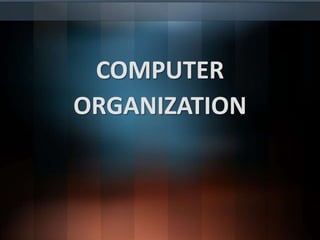Co m1-1
The document summarizes key concepts about computer organization and performance: 1. A typical computer instruction involves fetching an instruction from memory, reading operands from registers or memory, performing operations in the ALU, and writing results back to registers. The processor contains registers like the program counter, instruction register, and general purpose registers. 2. Performance is affected by the processor clock speed, instruction type, memory access time, and I/O devices. Key measures are elapsed time to execute a program and processor time spent actively executing instructions. 3. Multiple bus structures can improve concurrency but increase costs compared to single bus structures that are simpler but can become bottlenecks with many devices.

Recommended
Recommended
More Related Content
What's hot
What's hot (20)
Similar to Co m1-1
Similar to Co m1-1 (20)
Recently uploaded
Recently uploaded (20)
Co m1-1
- 3. Basic Operational Concepts: •A typical instruction may be like Add LOCA, R0 This instruction adds the operand at the memory location LOCA to the operand in a register R0 and places the result in the register. Similarly: Load LOCA, R1 Add R1,R0
- 4. • Figure below shows the connection between the memory and the processor Figure 1.2. Connections between the processor and the memory. Processor Memory PC IR MDR Control ALU Rn 1- R1 R0 MAR n general purpose registers
- 5. • The processor contains a number of registers used for different purposes. • The Instruction Register (IR) holds the instruction that is currently being executed. • The Program Counter(PC) is a specialized register which keeps track of the address of the next instruction to be fetched and executed. • The Memory Address Register(MAR) holds the address of the location to be accessed. • The Memory Data Register(MDR) contains the data to be written into or read out of the addressed location. • The n general purpose registers which stores the contents
- 6. Interrupt: • Normal execution of the program may be preempted if some device requires urgent servicing • In order to deal with the request, the normal execution is interrupted and the device raises the interrupt signal. • ISR (Interrupt Service Routine) • ISR saves the internal state of the processor, PC, the general registers and some control information. • When ISR is completed the state of the processor is restored and interrupted program may continue its execution.
- 7. Bus Structures • A group of lines that serve as a connecting path for several devices is called a bus. • The system bus has three parts: • Data bus • Address bus • Control bus • There are two types of bus: • Single bus structure • Multi bus structure
- 8. Single Bus Structure • All units are connected to a single bus. • Only two devices can connect at a time. • Single bus structure is vastly used because of its low cost and flexibility. • The device connected to the bus widely vary with their speed of operation. • Consider the transfer of an encoded character from the processor to the printer. Figure 1.3. Single-bus structure. MemoryInput Output Processor
- 9. • Drawback of Single Bus Structure: • The performance of the computer system suffers when large number of device is connected to the bus. • Propagation Delay • Bus- Bottleneck Multiple Bus Structure: • Achieve more concurrency • Leads to better performance • Increased cost
- 10. PERFORMANCE • Performance is the time taken by the system to execute a program. • The parameters that effect the performance are processor clock speed, type of instruction, memory access time, type of I/O devices connected, and data transfer capacity. • Elapsed time: The total time required to execute the program. • Processor Time: The period in which the processor is active.
- 11. • The processor cache
- 12. Processor Clock • Processor circuits are controlled by a timing signal called Clock. • The clock defines a regular time interval called clock cycles. • The length P of one clock cycle is an important parameter that effects the processor performance. Clock rate R=1/P • Where P- Length of one clock cycle. Clock Cycle P=I*CPI • Where I is number of instructions • CPI –Average clock cycle per instruction
- 13. Basic Performance Equation • Let T be the processor time required to execute a program. • Assume that complete execution of the program requires the execution of N machine language Instructions. • Suppose that average number of basic step needed to execute one machine instruction is S. • If the clock rate is R cycles per sec then the program execution time is given by T= N* S/ R (Basic performance Equation)
- 14. Clock Rate • There are two possibilities of increasing the clock rate R, • First, Improving the IC technology makes the logical circuit faster, which reduces the time of execution of basic steps, This allows the clock period P, to be reduced and the clock rate to be increased. • Second, Reducing the amount of processing done in one basic step.
- 15. Performance Measurement • Let us consider two programs P1 and P2 with first one having all operands in memory and second having all operands in CPU. Consider two computers C1 and C2. The clock speed of C1 is greater than that of C2. However memory access time in C1 is faster than C2. With these conditions which program gets executed faster??? Which computer is faster??
- 16. • Measure of instruction execution performance are based on average figures which are usually determined by measuring the runtimes of representative called benchmark program. • SPEC (System Performance Evaluation Corporation). • SPEC rating = Running time on the reference computer Running time on the computer under test Let SPEC I be the rating for the program I in the suite SPEC rating = Where n is the number of programs in the suite.
